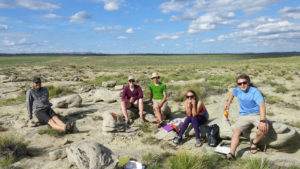As we begin our journey out of Billings, one thing about this part of Montana quickly becomes clear: it is very sparsely  populated. By humans, that is – as we ride along two-lane highways, sometimes there is little to be seen besides cow pastures and the occasional dirt road. Welcome to Big Sky country. It’s almost hard to believe that this seemingly empty place is actually the frontline in a heated battle over energy production in Montana, the United States, and even the world.
populated. By humans, that is – as we ride along two-lane highways, sometimes there is little to be seen besides cow pastures and the occasional dirt road. Welcome to Big Sky country. It’s almost hard to believe that this seemingly empty place is actually the frontline in a heated battle over energy production in Montana, the United States, and even the world.
Beneath this barren landscape lies a vast coal bed. The nearby Signal Peak coal mine in the Bull Mountains was recently granted a coal lease to mine over 60 million tons, in addition to other coal seams already in its possession. The Signal Peak mine is Montana’s only underground coal mine. For the most part, it utilizes the “longwall” mining technique. This method results in subsidence, which is when the underground voids leftover after the coal is mined are allowed to collapse. This can result in cracks and crevices on the surface. Land affected includes mine property, federal/public land, and private ranches.
Now this is where things get interesting. Typically, when we talk about opposition to coal, we talk about “liberal” opposition to pollution and other environmental impacts. But things are a little different here. It is a battle of economics, of land rights, of property damage, and of liability. Many ranching families have worked the land here for generations, and they fear that mining expansion will threaten their way of life. Water is a limited resource in these parts. There are concerns that the aquifers and other natural water sources in the Bull Mountains may be permanently altered by the subsidence, which would endanger the operations of many ranches.
This time around, the fight isn’t a partisan one. There are liberals and conservatives on both sides, debating the value of ranch land, mining jobs, and coal’s role in the greater Montana economy.
The fact is coal is declining as a power source in Montana and the nation. This decline is the result of stricter air quality regulations that are increasing the cost of operating coal plants, the dropping price of natural gas, and the Sierra Club’s surprisingly successful “Beyond Coal” campaign. This campaign has been effectively preventing the construction of new coal plants as well as shutting down older ones that don’t meet the new air quality regulations. The recent closure of the Corette plant is an example of coal’s decline in the face of increasing operational costs.
All that being said, coal is an important energy source for both Montana and the nation. Not only does the coal industry provide more jobs than renewable alternatives would, it also provides roughly 40% of our total energy. It is consistent, reliable, and usually cheap. Even if costs are rising, the vast infrastructure for coal-based energy is already in place. Furthermore, our country is very rich in coal deposits, so dependence on coal is neither a national security risk nor a resort to imports, like oil.
Even so, our priorities are shifting away from coal’s pollution and rising costs. The question is what takes its place? According to Lisa Perry at Northwestern Energy, hydroelectric power will not step up to fill the gap – the environmental effects of dams make it too difficult to add new hydroelectric facilities. In fact, the current trend is to remove current dams, not build new ones. Solar comes to mind, but the manufacture of solar panels requires massive amounts of heat, and therefore energy – energy that must first be provided by another source, such as coal. Not to mention the need for additional infrastructure and the installation of solar farms themselves. In Montana, wind seems to be the leading renewable energy source, but current technology doesn’t seem prepared to provide a consistent supply of energy. And, of course, we need additional infrastructure if wind energy is to be a solution. Northwestern Energy currently offsets the “stochastic” nature of wind energy with more controllable sources such as natural gas, which, for the time being, is very cheap and has far fewer emissions than other fossil fuels. Unfortunately, gas reserves will eventually be used up and prices will rise. Not to mention that natural gas extraction is closely linked to that of oil. Considering this externality, maybe natural gas isn’t so clean after all. Gas might be the answer for now, but… then what?
Whatever energy sources we choose will likely be selected by economics. We are adopting natural gas as its cost drops below coals, and will adopt the most affordable available source as soon as its cost rivals that of natural gas.
